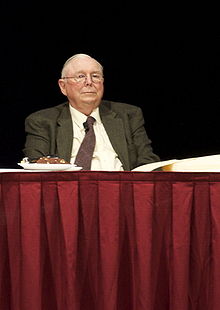Wesco Financial
| Wesco Financial Corporation | |
|---|---|
| legal form | Corporation |
| ISIN | US9508171066 |
| founding | 1959 |
| resolution | 2011 |
| Reason for dissolution | takeover |
| Seat |
Pasadena , California , |
| management | Charles Munger (Chairman & CEO) |
| Number of employees | 2,291 |
| sales | 765.7 million US dollars |
| Branch | Insurance, rental and leasing, trading, investment |
| Website | www.wescofinancial.com |
| As of December 31, 2010 | |
The Wesco Financial Corporation was a US -American holding company , which existed from 1959 by 2011. It was most recently an 80.1 percent subsidiary of Berkshire Hathaway , the investment company of US multi-billionaire Warren Buffett . Wesco, like Berkshire, owned several consolidated holdings and blocks of shares in various large US companies. This made it structurally very similar to its parent company, albeit many times smaller and with a different operational focus. From 1984 to the end, Chairman and CEO was Warren Buffett's “ alter ego ”, the US investor Charles Munger . The company was based in Pasadena in the US state of California .
history
Wesco was founded in 1959 by the Peters family and originally owned a savings bank , the Mutual Savings and Loan Association of Pasadena. In the same year some of the shares were floated on the stock exchange.
From 1972 onwards, Warren Buffett and Charles Munger gradually bought themselves into the company through their mutual investment vehicle, Blue Chip Stamps, and increased their stake to 80.1% by the late 1970s. Munger initially took on a supervisory board mandate and finally in 1984 the post of Chairman and CEO, making Wesco the third investment vehicle of his career as an investor after Wheeler, Munger & Co. and Blue Chip Stamps.
In the years that followed, the company's profits, like Berkshire itself, were used to acquire other companies and buy blocks of shares. Not only the profits from the investments, but also the financial reserves from the insurance business were used. The leverage effect achieved in this way was similar to a bank loan, but took place on considerably more favorable terms. Wesco also had this construction in common with Berkshire and was copied by other investment companies in the course of the 1970s.
As with Munger's previous ventures, Wesco's profit development also left the US benchmark index S&P 500 well behind, albeit a considerable way behind Berkshire Hathaway. Unlike Berkshire, Wesco paid out at least some dividend , most recently (2010) $ 1.64 per share, about 13.4% of net income.
In 2011 Berkshire took over the remaining 19.9% of the shares.
Business areas
The business activities spanned three different business areas:
- Insurance through Wesco-Financial Insurance Company (“Wes-FIC”), a property and casualty insurance company founded in 1985; and Kansas Bankers Surety Company (“KBS”), founded in 1909 and acquired in 1996, a specialist insurance policy maker for small and medium-sized businesses medium-sized banking companies. The gross written premium in 2010 was approximately 275 million US dollars, the annual profit after tax was 11 million dollars. Since the operating business was largely taken over by the Berkshire subsidiary National Indemnity, this division only has 14 employees despite its high sales figures.
- Furniture rental and leasing through CORT Business Services Corporation. This company, which was created in 1972 through the merger of five rental companies, was acquired in 2000. Here (2010) around 2100 employees generated annual sales of 367 million US dollars.
- Steel trading by Precision Steel Warehouse Inc., founded in 1940. The company, which was acquired in 1979, had annual sales of around 48 million US dollars in 2010 with its 172 employees.
The originally operated savings bank business was given up in 1993.
In addition to the aforementioned consolidated holdings, Wesco owned blocks of shares in various major US companies. It included stocks like Wells Fargo , Procter & Gamble, and Coca-Cola, and was very similar to Berkshire's investments. The total price value of the shares last added up (December 31, 2010) to 1.85 billion dollars.
Individual evidence
- ↑ a b c d e Annual Report 2010 (Form 10-K). (PDF; 471 kB) Wesco Financial Corporation, February 25, 2011, accessed on February 20, 2013 .
- ↑ Roger Lowenstein: Buffett: The Story of an American Capitalist . Börsenmedien AG, Kulmbach 2009, ISBN 978-3-938350-87-4 , p. 279 ff., 300 .
- ^ Securities and Exchange Commission (Ed.): SEC News Digest . Washington DC June 1, 1959, p. 3 ( sec.gov [PDF]).
- ↑ Lowenstein, Roger: Buffett: The Story of an American Capitalist . Börsenmedien AG, Kulmbach 2009, ISBN 978-3-938350-87-4 , p. 285 ff .
- ↑ Proxy Statement for Annual Meeting of Shareholders May 5, 2010. (PDF; 127 kB) Wesco Financial Corporation, March 27, 2010, accessed on February 21, 2013 .
- ↑ Lowenstein, Roger: Buffett: The Story of an American Capitalist . Börsenmedien AG, Kulmbach 2009, ISBN 978-3-938350-87-4 , p. 235 f .
- ↑ Wesco's stock market value rose from around 40 million dollars in the mid-1970s to more than 2.7 billion dollars most recently. Berkshire rose from $ 87 per share to around $ 120,000 per share between 1973 and 2010, and the S&P 500 rose from 97.55 points to 1257.64 points over the same period.
- ↑ Annual Report 1997. (PDF; 287 kB) Wesco Financial Corporation, March 13, 1998, accessed February 20, 2013 .

